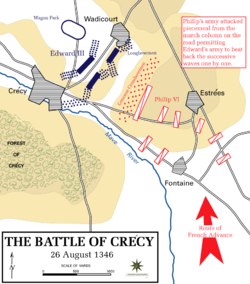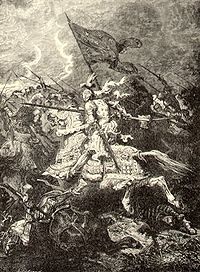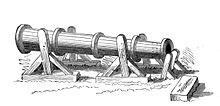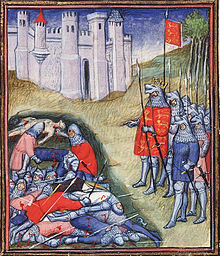- Battle of Crécy
-
Battle of Crécy Part of the Hundred Years' War 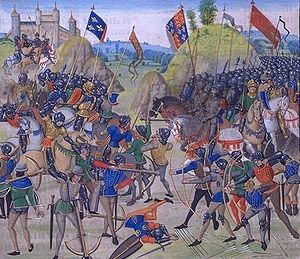
Image from a 15th-century illuminated manuscript of Jean Froissart's ChroniclesDate 26 August 1346 Location South of Calais, near Crécy-en-Ponthieu, Somme
50°15′25″N 1°54′14″E / 50.257°N 1.904°ECoordinates: 50°15′25″N 1°54′14″E / 50.257°N 1.904°EResult Decisive English victory Belligerents  Kingdom of England
Kingdom of England
 Allied knights from the Holy Roman Empire
Allied knights from the Holy Roman Empire Kingdom of France
Kingdom of France
 Genoese Mercenaries
Genoese Mercenaries
 Kingdom of Navarre
Kingdom of Navarre
 Kingdom of Bohemia
Kingdom of Bohemia
 Kingdom of Majorca
Kingdom of MajorcaCommanders and leaders Edward III of England
Edward, the Black PrincePhilip VI of France (WIA)
King John of Bohemia †Strength 4,000 knights/men at arms
7,000 longbowmen
5,000 spearmen
5 cannons6,000 crossbowmen
12,000 men at arms
20,000–25,000 other infantryCasualties and losses 2 knights killed
Several hundred killed11 Noblemen killed
1,542 Knights killed
2,300 Genoese Crossbowmen killed
Several thousand infantry killedCadsand – Arnemuiden – English Channel – Sluys – Saint-Omer – Auberoche – Caen – Blanchetaque – Crécy – Calais – Neville's Cross – Les Espagnols sur Mer – PoitiersThe Battle of Crécy (occasionally written the Battle of Cressy in English) took place on 26 August 1346 near Crécy in northern France, and was one of the most important battles of the Hundred Years' War. The combination of new weapons and tactics has caused many historians to consider this battle the beginning of the end of classic chivalry.
Contents
Summary
Crécy was a battle in which an Anglo-Welsh army of 9,000 to 15,000 (depending on source), commanded by Edward III of England and heavily outnumbered by Philip VI of France's force of 35,000 to 100,000 (depending on source),[1] was victorious as a result of superior weaponry and tactics, demonstrating the importance of the modern military concept of fire power. The effectiveness of the English longbow, used en masse, was proven against armoured knights, contrary to the conventional wisdom of the day which held that archers would be ineffective and be butchered when the armoured units closed in.
In the battle, the French knights, protected by mail reinforced with plate, nearly exhausted by charging several miles into the fray (against their king's wishes) and having to walk through a quagmire of mud to charge up a shallow hill into English and Welsh arrow storms, were cut down. The result was that much of the French nobility died, perhaps even a third (estimates of the actual numbers in each army vary considerably, depending on the source).
Knights' armour had not yet evolved to the stage where longbows could not penetrate, and the knights' horses were barely protected at all. The storm of arrows killed or disabled the knights' mounts, and left the knights floundering in the mud on foot beneath an unavoidable hail of arrows.
Just as importantly, the bolts of the hired Genoese crossbowmen who were at the forefront of the battle were unable to reach the defending English. Their quarrels fell short of the English because the Genoese's crossbow's strings were wet and they had misjudged the range and shot too early and too low. The English, controlling the high ground, were able to run a short distance down the hill and easily pick off the Genoese with volleys of arrows. As the Genoese attempted to retreat, they were cut down by the French knights, who considered the withdrawal to be cowardly, and this wasted the first Conroi charge of French cavalry on the Genoese, leaving them disorganized for the charge on the English.
The battle is seen by many historians as marking the beginning of the end of classic chivalry, although the earlier battle of the Golden Spurs could also be viewed in this light; during the course of the battle, many of the prisoners and wounded were killed. This was against the chivalric codes of warfare, and knights on horseback were no longer "undefeatable" by infantry.
Crécy may also have seen the first real use of cannon on the European battlefield, which were used only in small numbers by a few states during the 1340s. "Ribaldis", a type of cannon, were first mentioned in the English Privy Wardrobe accounts during preparations for the battle between 1345 and 1346, and they were perhaps employed against both the Genoese and the cavalry.[2] Similar cannon would appear also at the Siege of Calais in the same year, although it would not be until the 1380s that the "ribaudekin" was mounted on wheels.[2] The use of firearms at this battle is only mentioned in one contemporary account of the battle, that of Villani (d. 1348). Villani did travel abroad during much of the early 14th century, yet he had returned to his home in Florence at the time of the Battle of Crécy, so his information was likely second hand if not third or fourth hand. His account also conflicts with almost all of the other contemporary chronicles of this time on the events of the battle, specifically the use of firearms. In one of the later versions of his chronicle, Froissart does mention guns being used in the battle, but by that time firearms had become more common in warfare. His earlier versions fail to include any mention of firearms. So while firearms were perhaps employed, their possible effect on the battle should be viewed critically.[3]
The political consequences of the battle were significant especially for Edward III, who had financed and supplied his expedition to Normandy with increasingly unpopular policies. The widespread use of purveyance and the arresting of ships to provide transport for his armies had left the King with potential sources of discontent in his kingdom. Likewise, the bold and unprecedented move to expand compulsory service, usually required only for defence of the coasts, to supply overseas service in France proved to be deeply unpopular with many of his subjects. However, the successes of the campaign did much to mute opposition when Parliament was convened on 13 September 1346.
English casualties were light, but there were thousands of French and allied dead, among them the counts of Flanders, Alençon, and Blois, Rudolph, Duke of Lorraine, and King John of Bohemia, a French ally, father of Charles IV of the House of Luxembourg (future Holy Roman Emperor). Charles lost many of his best knights, with Charles himself escaping wounded from the field.
Background
Following the outbreak of war in 1337, the Battle of Sluys was the first great battle of the Hundred Years' War, on 24 June 1340. In the years following this battle, Edward attempted to invade France through Flanders, but failed due to financial difficulties and unstable alliances. Six years later, Edward planned a different route, and put into action a massive raid through the lands of Normandy, winning victories at Caen on 26 July and the Battle of Blanchetaque on 24 August. A French plan to trap the English force between the Seine and the Somme Rivers failed, and the English escape led to the Battle of Crécy, one of the greatest battles in the whole war.
Nobles and Men at Arms at the Battle
The king afterwards ordered, through his constable and his two marshals, that the army should be divided into three battalions. In the first, he placed the young prince of Wales, and with him the earl of Warwick, and earl of Oxford, sir Godfrey de Harcourt, the lord Raynold Cobham, lord Thomas Holland, lord Stafford, lord Mauley, the lord Delaware, sir John Chandos, lord Bartholomew Burgherst, lord Robert Neville, lord Thomas Clifford, the lord Bourchier, the lord Latimer, and many other knights and squires whom I cannot name. There might be, in this first division, about eight hundred men at arms, two thousand archers, and a thousand Welshmen. They advanced in regular order to their ground, each lord under his banner and pennon, and in the centre of his men. In the second battalion were the earl of Northampton, the earl of Arundel, the lords Roos, Willoughby, Basset, Saint Albans, sir Lewis Tufton, lord Multon, the lord Lascels, and many others; amounting, in the whole, to about eight hundred men at arms, and twelve hundred archers. The third battalion was commanded by the king, and was composed of about seven hundred men at arms, and two thousand* archers. [4] Sir Thomas Felton fought at the battles of Crécy and Poitiers. [5] He was also a member of the Order of the Garter.[6]Others included Sir Richard Fitz-Simon, Sir Miles Stapleton, William de Bohun, Ist Earl of Northampton, Sir John Sully and Sir Richard Pembrugge.
English dispositions
As in previous battles against the Scots, Edward III disposed his forces in an area of flat agricultural land, choosing high ground surrounded by natural obstacles on the flanks. The king installed himself and his staff in a windmill on a small hill that protected the rear, where he could direct the course of the battle.
In a strong defensive position, Edward III ordered that everybody fight on foot and distributed the army in three divisions, one commanded by his sixteen-year-old son, Edward, the Black Prince. The longbowmen were deployed in a "V-formation" along the crest of the hill. In the period of waiting that followed, the English built a system of ditches, pits and caltrops to maim and bring down the enemy cavalry. Forcing the knights to fight on foot had several advantages: It prevented them from starting a premature charge; ensured protection for the archers, should the French manage to close the distance; and ensured that the archers and supporting infantry stayed on the battlefield rather than running at the first opportunity (a common occurrence in medieval warfare).[7]
Battle
The French army commanded by Philip VI was much more disorganized, due to overconfidence on the part of his knights. Against Philip's orders, his knights insisted upon fighting immediately after their arrival, rather than gathering their strength for a battle the next day. Philip stationed his Genoese mercenary crossbowmen, under Ottone Doria, in the front line, with the cavalry in the back. The French even went as far as to leave behind the pavises, the only means of defence for the crossbowmen, along with the other infantry. Both decisions proved deadly mistakes. French chronicler Froissart gives an account of the action:
The English, who were drawn up in three divisions and seated on the ground, on seeing their enemies advance, arose boldly and fell into their ranks...You must know that these kings, earls, barons, and lords of France did not advance in any regular order... There were about fifteen thousand Genoese crossbowmen; but they were quite fatigued, having marched on foot that day six leagues, completely armed, and with their crossbows. They told the constable that they were not in a fit condition to do any great things that day in battle. The earl of Alençon, hearing this, said, "This is what one gets by employing such scoundrels, who fail when there is any need for them."Froissart was a careful chronicler but it will be apparent from such anglicisms as "earl of Alençon" that something has been lost in translation. In particular, although fifteen thousand Genoese may have landed at Harfleur, Giovanni Villani believed only six thousand crossbowmen made it to the field of battle, which became the consensus view[10]
The first attack was from the crossbowmen, who launched a series of volleys with the purpose of disorganizing and frightening the English infantry. This was accompanied by the sound of musical instruments, brought by Philip VI for scare tactics. However, the crossbowmen proved completely useless; with a shooting rate of around 1–2 shots per minute, they were no match for the longbowmen, who could shoot five or six arrows in the same amount of time, and also had superior range due to their bows and elevation. Furthermore, their weapons were damaged by the brief thunderstorm that had preceded the battle, while the longbowmen had unstrung their bows until the rain stopped – in fact Froissart relates that they did not withdraw their bows from their covers or sheaths till the first volley from the Genoese failed: "Les archers anglois découvrent leurs arcs, qu'ils avoient tenus dans leur étui pendant la pluie".[9] The crossbowmen also did not have their pavises, which would have provided cover for the men during the long reloading procedure but remained in the baggage train. Under the hail of English arrows, the Genoese crossbowmen suffered heavy losses and were unable to approach the English lines to where their crossbows would have been effective. Their commanders, including Doria, died trying to rally their men. Frustrated and confused, the crossbowmen retreated. The knights and nobles, upon seeing the mercenaries routed, hacked them down as they came back to their lines ("Kill this rabble impeding our way").
By the time this contretemps ended, several volleys of longbow arrows had already fallen among the French. At this the French knights decided it was time to charge, and they ran right over the retreating mercenaries in an unorganized way. It was at this point that the mercenaries cut the strings of their crossbows, presumably to indicate surrender. The English and Welsh longbowmen continued shooting as the knights and men-at-arms advanced, and many French fell along the way,[11] whereupon the Welsh and Irish skirmishers slit their throats.
Froissart writes that English cannon had made "two or three discharges on the Genoese", which is taken to mean individual shots by two or three guns because of the time necessary to reload such primitive artillery.[2] These were believed to shoot large arrows and primitive grapeshot. The Florentine Giovanni Villani agreed that they were destructive on the field, though he also indicated that the guns continued to fire upon French cavalry later in the battle:
The English guns cast iron balls by means of fire...They made a noise like thunder and caused much loss in men and horses...The Genoese were continually hit by the archers and the gunners...[by the end of the battle] the whole plain was covered by men struck down by arrows and cannon balls.—[2]With the crossbowmen defeated, the French cavalry charged again in organized rows. However, the slope and man-made obstacles disrupted the charge. At the same time, the longbowmen continued shooting volleys of arrows upon the knights. Each time, more men fell, blocking successive waves of advance. The French attack could not break the English formation, even after 16 attempts, and they suffered frightful casualties. Edward III's son, the Black Prince, came under attack, but his father refused to send help, saying that he wanted him to "win his spurs". The prince subsequently proved himself to be an outstanding soldier.
Philip himself was wounded, and, at nightfall, ordered the French to retreat. It was a disastrous and humiliating defeat for France and an overwhelming victory for England.
Aftermath
After the French left the field, the English looked through the wounded French to see who was worth ransom. Those knights who were too severely wounded to be easily carried off the field were dispatched with misericordias (mercy-givers). These were long daggers which were inserted through the unprotected underarms and into the heart, or through visor slits and into the brain. This was against the chivalric codes of warfare, since peasants were killing knights; knights were also dying from anonymous arrow shots rather than face to face in combat with peers.
This battle established the military supremacy of the English / Welsh longbow over the French combination of crossbow and armoured knights (due to the yeoman archer's significantly greater rate of fire and range than that of the contemporary crossbow) and altered significantly the way in which war was conducted for a considerable period of time thereafter. After the Battle of Crécy, Edward III went on to besiege the city of Calais, which surrendered to him after eleven months, giving the English a base in northern France. The next major battle in the Hundred Years War, the Battle of Poitiers in 1356, would see another defeat for the French, under very similar conditions.The French dead included:
King John of Bohemia[12]
Duke of Lorraine
Louis I, Count of Flanders
Charles II, Count of Alençon
Louis II, Count of Blois
The Viscount Rohan
The Lord of Laval
The Lord of Chateaubriant
The Lord of Dinan
The Lord of RedonAt this stage in history the longbow was capable of penetrating armour (particularly the parts not yet covered by plates), but not all the arrows shot by the longbowmen would have found a target or penetrated the armour of the advancing French knights if they did, partly due to angles at which they happened to strike. However, victims would have their horses shot out from under them, and it is worth remembering that even a non-piercing impact would still be substantial enough to bruise, wind and knock down knights on foot as they attempted to advance. Froissart claimed the barrages of arrows were so heavy and frequent that they blotted out the sun, and even allowing for some poetic licence, not every arrow would have needed to find a target. If survivors of the volleys reached the English formation, they were cut down with relative ease by the defensive line of dismounted English men-at-arms. The overall effect was devastating.
After the battle, the Black Prince, having won respect and honour, was triumphant. Yet he did not go straight to his father Edward III, but stayed on the battle field to pay his tribute to a stranger—King John of Bohemia. John was a middle-aged man who was almost blind, and yet he fought very bravely during the battle. Edward of Woodstock, the Black Prince, was deeply impressed by his courage and mourned the loss of a hero. As a last gesture of admiration and respect, he took the old king's shield and made it his own (Prince of Wales's feathers). It is now a famous symbol throughout England and Wales, being the crest of the Surrey County Cricket Club and the Welsh Rugby Union.
When the battle was over and the Welsh longbowmen had returned to their home in Llantrisant, South Wales, they were each given an acre of land for their bravery. They were also awarded "Freemen" status and were exempted from paying tax for grazing rights for their cattle.
Example for future battles
A few Portuguese soldiers fought alongside the Black Prince, and brought to Portugal reports of the new tactics. Decades later, during the 1383–1385 Crisis, the general Nuno Álvares Pereira used these tactics against the Castilians; first at the Battle of Atoleiros in 1384 against the Castilian cavalry and then (with the support of several English bowmen) at the Battle of Aljubarrota against the French and Castilians.[citation needed] The outcomes were spectacular: total victory in both battles, zero losses at Atoleiros.[13]
Fictional accounts
A fictional portrayal of the Battle of Crécy is included in the Ken Follett novel World Without End.[14] The novel describes the battle from an English knight's perspective and from that of a neutral observer.
Another can be found in Warren Ellis' graphic novel Crécy or in Bernard Cornwell's fictional account of an archer in the Hundred Years War, The Archer's Tale (US title) or Harlequin (UK title).
It also appears in "The campaign of 1346, an historical drama" by Christopher Godmond.
The battle is portrayed in Ronald Welch's Bowman of Crécy.
The protagonist, Edmund Beche, in P.C. Doherty's The Death of a King (1985) is present at the battle and describes it from the perspective of a bowman on the right flank near the village of Crécy.
See also
- Medieval warfare
- Battle of Agincourt in 1415 for a similar battle won by English/Welsh longbowmen
- Battle of Poitiers in 1356
Footnotes
- ^ John A. Lynn, Battle: A History of Combat and Culture, Cambridge, MA: Westview Press, 2003. p. 74.
- ^ a b c d David Nicolle, Crécy 1346: Triumph of the longbow, Osprey Publishing; 25 June 2000; ISBN 9781855329669.
- ^ Andrew Ayton and Sir Philip Preston, The Battle of Crecy
- ^ http://www.elfinspell.com/FroissartCh125Style.html Chpt CXXVII.
- ^ http://www.archive.org/stream/dictionarynatio23stepgoog#page/n321/mode/1up p308 col. 2
- ^ ^ http://www.heraldica.org/topics/orders/garterlist.htm 67 (app c.1381)
- ^ http://www.elfinspell.com/FroissartCh125Style.html
- ^ Amt, p. 330.
- ^ a b Chateaubriand, 'Invasion de la France par Edouard', in Volume 7 from the complete works of 1834; pg37.
- ^ Cf. Encyclopedia Brittanica 11th Edition Vol. 7 pg 389d, 'Crécy'.
- ^ Amt, p. 331.
- ^ Venette, Jean. The Chronicle of Jean de Venette. Edited and Translated by Jean Birdsall. New York: Columbia University Press, 1953. (Venette only mentions King John of Bohemia)
- ^ History of Portugal: Pamphlet Collection (197?) ISBN 1001287800, p.176
- ^ Follett, Ken (2007). World without end. Pan Macmillan. ISBN 978-0-333-90842-6.
References
Primary sources
- The Anonimalle Chronicle, 1333–1381. Edited by V.H. Galbraith. Manchester: Manchester University Press, 1927.
- Avesbury, Robert of. De gestis mirabilibus regis Edwardi Tertii. Edited by Edward Maunde Thompson. London: Rolls Series, 1889.
- Chronique de Jean le Bel. Edited by Eugene Deprez and Jules Viard. Paris: Honore Champion, 1977.
- Dene, William of. Historia Roffensis. British Library, London.
- French Chronicle of London. Edited by G.J. Aungier. Camden Series XXVIII, 1844.
- Froissart, Jean. Chronicles. Edited and Translated by Geoffrey Brereton. London: Penguin Books, 1978.
- Grandes chroniques de France. Edited by Jules Viard. Paris: Société de l'histoire de France, 1920–53.
- Gray, Sir Thomas. Scalacronica. Edited and Translated by Sir Herbert Maxwell. Edinburgh: Maclehose, 1907.
- Le Baker, Geoffrey. Chronicles in English Historical Documents. Edited by David C Douglas. New York: Oxford University Press, 1969.
- Le Bel, Jean. Chronique de Jean le Bel. Edited by Jules Viard and Eugène Déprez. Paris: Société de l'historie de France, 1904.
- Rotuli Parliamentorum. Edited by J. Strachey et al., 6 vols. London: 1767–83.
- St. Omers Chronicle. Bibliothèque Nationale, Paris, MS 693, fos. 248-279v. (Currenting being edited and translated into English by Clifford J. Rogers)
- Venette, Jean. The Chronicle of Jean de Venette. Edited and Translated by Jean Birdsall. New York: Columbia University Press, 1953.
Anthologies of translated sources
- Life and Campaigns of the Black Prince. Edited and Translated by Richard Barber. Woodbridge: Boydell Press, 1997.
- The Wars of Edward III: Sources and Interpretations. Edited and Translated by Clifford J. Rogers. Woodbridge: Boydell Press, 1999.
Secondary sources
- Ayton, Andrew; Preston, Philip; et al. (2005). The Battle of Crecy, 1346. Boydell Press. http://www.boydell.co.uk/43833069.HTM.
- Amt, Emilie, ed (2001). Medieval England 1000–1500: A Reader. Peterborough, Ontario: Broadview Press. ISBN 1551112442.
- Barber, Richard. Edward, Prince of Wales and Aquitaine: A Biography of the Black Prince. Woodbridge: Boydell Press, 2003.
- Burne, Alfred H. The Crecy War: A Military History of the Hundred Years War from 1337 to the peace of Bretigny, 1360. New York, NY: Oxford University Press, 1955.
- DeVries, Kelly. Infantry Warfare in the Early Fourteenth Century. Woodbridge, UK: Boydell Press, 1996.
- Hewitt, H.J. The Organization of War under Edward III. Manchester: Manchester University Press, 1966.
- Medieval Warfare: A History. Edited by Maurice Keen. Oxford, UK: Oxford University Press, 1999.
- Lynn, John A. "Battle: A History of Combat and Culture". Cambridge, MA: Westview Press, 2003.
- Nicolle, David (2000). Crécy 1346: Triumph of the longbow. Oxford: Osprey Publishing. ISBN 1855329662.
- Ormrod, W.D. The Reign of Edward III. Charleston, SC: Tempus Publishing, Inc, 2000.
- Packe, Michael. King Edward III. London, UK: Routledge & Kegan Paul plc, 1985.
- Prestwich, Michael. Armies and Warfare in the Middle Ages: The English Experience. New Haven, CT: Yale University Press, 1996.
- Prestwich, Michael. The Three Edwards: War and State in England, 1272–1377. New York, NY: St. Martin's Press, 1980.
- Reid, Peter. A Brief History of Medieval Warfare: The Rise and Fall of English Supremacy at Arms, 1314–1485. Philadelphia: Running Press, 2007.
- Rogers, Clifford J. Essay on Medieval Military History: Strategy, Military Revolution, and the Hundred Years War. Surrey, UK: Ashgate Variorum, 2010.
- Rogers, Clifford. War Cruel and Sharp: English Strategy under Edward III, 1327–1360. Woodbridge, UK: Boydell Press, 2000.
- Seward, Desmond. The Hundred Years War: The English in France 1337–1453. London, UK: Constable and Company Ltd., 1996.
- Sumption, Jonathan. The Hundred Years War, Volume I: Trial by Battle. Philadelphia, PA: University of Pennsylvania Press, 1990.
- The Hundred Years War. Edited by Kenneth Fowler. Suffolk, UK: Richard Clay. The Chaucer Press, 1971.
- Waugh, Scott L. England in the reign of Edward III. Cambridge: Cambridge University Press, 1991.
Categories:- 1346 in France
- Battles of the Hundred Years' War
- Somme
- Battles involving Bohemia
- Conflicts in 1346
- Cavalry charges
Wikimedia Foundation. 2010.

